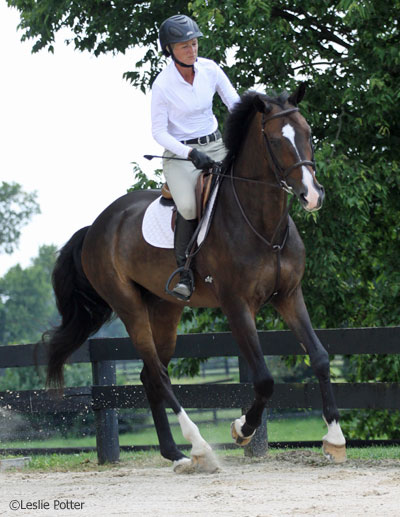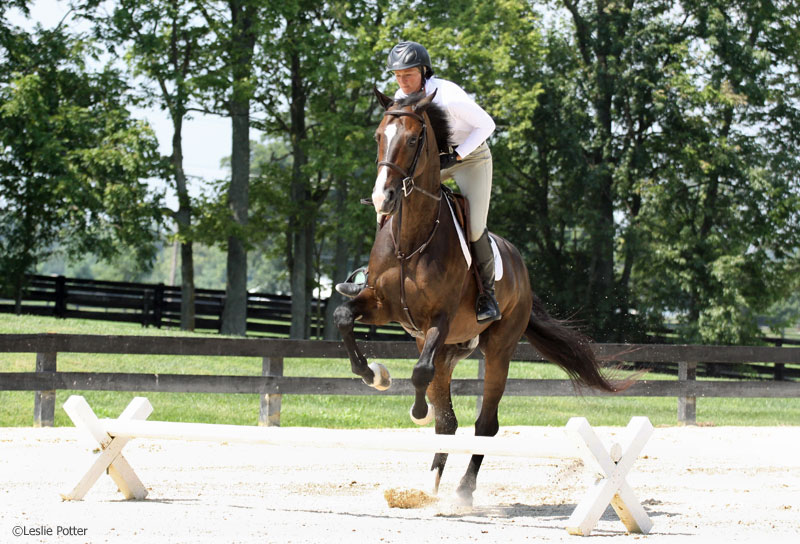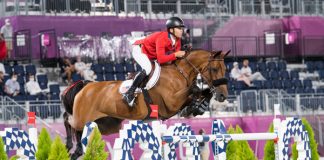 Even if you can nail the distance to every fence, your hunter is sure to stay out of the ribbons if he can’t easily perform a flying lead change. The following tips will help you learn how to ask for a change from a green horse or sharpen up an older campaigner.
Even if you can nail the distance to every fence, your hunter is sure to stay out of the ribbons if he can’t easily perform a flying lead change. The following tips will help you learn how to ask for a change from a green horse or sharpen up an older campaigner.
Smooth Change
Melissa Murphy, owner and trainer at Murphy Manor in Lexington, Ky., offers some advice on how to teach a horse to perform a clean lead change. She trains hunter, jumper and equitation horses, and teaches both junior and adult amateur riders.
“A flying lead change is extremely important to a horse’s training,” says Murphy. “It shows the results of a balanced horse understanding how to react to lateral movement, and how to be supple in moving up in rhythm or coming back to a collected gait. It also shows the communication between a horse and rider.”
Key Ingredients
Murphy stresses that every horse is an individual. Learning flying lead changes will be easier for some horses than it is for others. There are seven skills a horse must understand and be able to perform before you can ask him for a lead change.
- A balanced horse has equal weight distributed over both the front and the hind end, which allows him to easily change direction and pace. A horse that is able to hold himself in this balanced position will be able to correctly perform a lead change.
- Straightness is key to correctly asking for a change. Your horse’s spine has to be straight to allow him to lift the opposite shoulder and hip to strike off on the other lead. Choose a focal point to concentrate on and ride toward, whether it’s a tree, cone or a point in the ring. This targeted attention will allow you to keep your shoulders straight, which will translate into a straight horse.
- Your horse must have impulsion in order to create the energy necessary to push off onto the correct lead. If he’s not engaged in a true, three-beat canter, he won’t have enough power behind to cleanly step into the lead change. He doesn’t need to be galloping to get a change, but he does need to have his motor revving.
- To get a nice change, your horse must also be able to easily lengthen and collect his stride. This adjustability will allow you to ask him to move up to the spot where you will ask for a lead change or collect himself and wait for your cue to do so.
- Your horse must also perform consistent walk-to-canter transitions. This sharpness to your aids will allow him to quickly do what you are asking and understand the basics of a flying change.
- Your horse must be supple, or able to bend easily, no matter what gait he is in; this quality can be honed by riding small circles in different parts of the arena.
- Also important is lateral work: your horse’s ability to move sideways off your leg.
How to Ask For a Change
There are certain clear signals you need to give your horse in order for him to understand what you’re asking. First, as you approach the point where you will ask for the change, you’ll need to shift your weight to the opposite side (outside) of the lead you are on.
While traditionally your inside leg is at the girth and your outside leg a bit behind the girth as you canter around the ring, as you approach the point where you will ask for a change, these leg positions will switch. For example, if you’re tracking right, your right leg is at the girth and your left leg is a bit behind the girth, pushing the hindquarters in and holding the lead. As you approach the change, your left leg then becomes your new inside leg at the girth and your right leg sits a bit behind the girth.
You will also change your horse’s bend from right to left in preparation for the change. His whole body will need to be bent, not just his head and shoulders. Add right leg to physically push him over to the new lead. Raising your hand on the side of the lead you’re asking for (in this case, your left) may also help him understand your request.
The concept of asking for a lead change is really “set-set-ask,” meaning that there are two steps needed to prepare your horse to cleanly change.

The Inexperienced Horse
When teaching an inexperienced horse how to get a lead change, Murphy uses a pole or cavalletti on the ground to help him learn when to make the change. This helps the horse associate the timing of the pole with the moment he will be asked for a change. He’s then able to feel the leg aids and associate where his body should be positioned for a change. As with all exercises, Murphy emphasizes the need to not drill a horse on one concept. Once your horse has completed it well a few times, quit and work on it another day.
Most horses understand how to switch with their front end but have a more difficult time switching the hind end in a lead change. With proper collection and balance, as well as relaxation and rhythm, the lead change will simply be included in a canter stride.
A basic exercise to teach your horse how and when to change his lead is to ride a simple figure-eight in the ring. Starting out in the canter, break to the trot for a simple change as you cross through the middle of the eight. Your horse should be reactive to your leg and begin to understand the timing of when he will be expected to change his leading legs.
Once your horse is consistent in this basic exercise, add a pole in the middle of the figure where you originally asked him to break to the trot and change leads. Generally, the process is very similar to the first exercise, but the pole enhances the collection in the trot before the canter departure. After a few times over the pole, you will feel your horse anticipating changing leads; you can then ask for a lead change without breaking to the trot by slightly changing the bend and shifting your weight to the outside stirrup (also called “stepping out”).
Again, Murphy warns that this is not an exercise to be drilled; once your horse tries to change his leads a few times over the pole, praise and reward him and finish learning changes for the day.
A third exercise Murphy uses with green horses involves the counter-canter. The key to teaching consistent changes is to not rush inexperienced horses through them. Teaching a horse to hold the counter-canter in one large circle around the ring should not overwhelm or scare him. If he’s having a tough time holding the “wrong” lead, think of shifting his hips to the outside before each corner to encourage him to stay in the counter-canter. When he understands the counter-canter, ask for the change before coming into the corner; it’s easier for horses to understand a request for a change on a straight line.
Crisp Changes
If your horse is sticky with changes, Murphy recommends using the quarter lines of the arena. Turn your horse up the quarter line, walk a few steps and then ask for the right or left lead. Canter a few steps and then transition back down to the trot. This exercise strengthens a horse’s hind end by asking him to really push off into the canter; it also forces him to pay attention to which leg you are cueing him with to determine which lead he’s supposed to take.
Additionally, using the long side of the arena forces you to create your own straight line. Working off the rail makes it easier to work with leads, as your horse won’t anticipate which lead he is supposed to take.
Ease Anticipation
Some horses become so enthusiastic once they learn how to change leads that they want to prove they can do it all the time! A horse that anticipates a change can keep you out of the ribbons just as easily as a horse that doesn’t get a change.
Murphy has a few exercises to prevent a horse from anticipating changes, including holding the counter-canter instead of letting your horse switch to the more comfortable, correct lead. Practice circles, changes of direction, and changes from the correct lead to the counter-canter to keep your horse guessing as to what’s coming next. You can also ask for a lead change and then counter-canter across the diagonal and through the corner to make your horse focus on you so he doesn’t anticipate a change.
In the third exercise, canter straight down the centerline and keep your horse moving off your legs, but don’t ask for a change. This demands that your horse pay attention to you yet remain supple and elastic in his stride while not anticipating.
Lead changes aren’t meant to be a make-or-break move to keep you out of the ribbons at a horse show. Learning to do them well will ensure that your horse is balanced and ready to find the perfect distance to the next jump, which will make you look good in the process!
Special thanks to Melissa Murphy riding Picasso, owned by Emmy Trussell, for assistance with these photos.
Further Reading
Teaching Lead Changes
Troubleshooting Flying Lead Changes
This article originally appeared in the November 2013 issue of Horse Illustrated. Click here to subscribe.






great tips!
Ah to dream.
I would never remember all of that….sometimes, I have a hard enough time just getting on my horse!!
Never thought of using a cavaletti or a small jump! great idea!